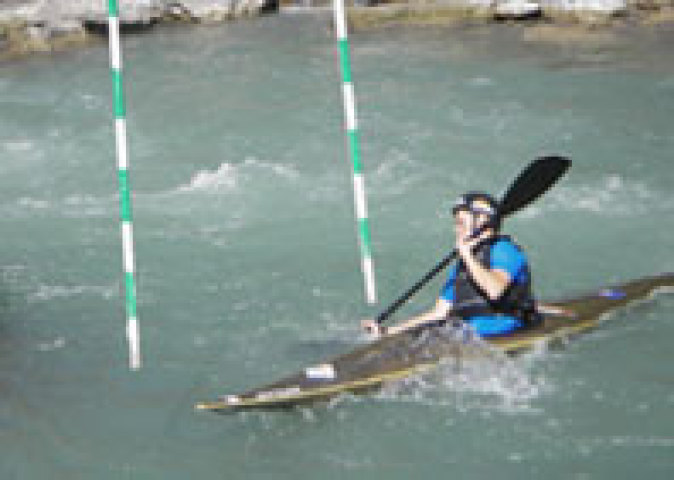
Alexander Grimm’s story
When he won the slalom gold medal at the last Olympic Games in 2008 at Beijing after an amazing display of precision kayaking, German Alexander Grimm shot to the top of the popularity charts in his country. In France, a little less so … because he snatched the medal from Frenchman Fabien Lefèvre, the big favourite in the discipline. At 25 years of age, Alexander is, nevertheless, keeping a cool head and is preparing meticulously for his upcoming major events.
A conversation with a sportsman who pays as much attention to his preparation as to the manufacture of his boats.
When did you start kayaking ?
Like many children, I played football first of all. My training centre was in Augsburg (Bavaria), close to where the canoe/kayak trails took place for the 1972 Olympics. After “kicking the ball around”, I used to like watching the kayakers. This sport intrigued me and I really fancied trying it. At the age of nine I took the plunge and signed up with a kayak club…
Barely a year after starting it, I took part in my first competition. That was in 1996, at Dilligen on the Danube. I came second in my category.

How often do you train ?
 Kayaking is very technical, which is why I am generally on the water twice a day. My day doesn’t stop there, however. In the evening I go to a sports hall for a muscle-building session.
Kayaking is very technical, which is why I am generally on the water twice a day. My day doesn’t stop there, however. In the evening I go to a sports hall for a muscle-building session.
What is the secret to your success?
Keeping calm in all circumstances, to soak up the pressure! In training, as in competition, technique and a cool head are decisive.
Do you have any time left to think of anything other than kayaking?
Like everybody, I have other passions too. I like mountain biking and snowboarding… But I am also preparing for my future because a sportsman’s career is short. I am studying mechanical engineering.
What materials were your first boats made of ?
 I am a child of the plastic generation! So, and I am very happy about it, I have never known folding kayaks made of canvas and wood. Paddling in a competition in contraptions like that must have been a real feat. Those boats are now historical pieces in museums because the first plastic kayaks came out in the 50s. Today, building competition boats is a highly technological matter, especially since the appearance of aramid and carbon fibres. Making boats with these components allows real precision work. Having said that, this technology is still only accessible for boats intended for high-level competitors. When I began, I went out on polyethylene kayaks which, whilst not having the present qualities of Olympic kayaks, were nevertheless fairly high-performance!
I am a child of the plastic generation! So, and I am very happy about it, I have never known folding kayaks made of canvas and wood. Paddling in a competition in contraptions like that must have been a real feat. Those boats are now historical pieces in museums because the first plastic kayaks came out in the 50s. Today, building competition boats is a highly technological matter, especially since the appearance of aramid and carbon fibres. Making boats with these components allows real precision work. Having said that, this technology is still only accessible for boats intended for high-level competitors. When I began, I went out on polyethylene kayaks which, whilst not having the present qualities of Olympic kayaks, were nevertheless fairly high-performance!
Are your boats governed by standards ?
Absolutely, the standards are laid down by the international federation. Without talking about monotypes (where all the boats are strictly identical), a slalom kayak must have a minimum length and width of 350 cm and 60 cm respectively, and weigh at least 9 kg. The whole art, therefore, is to get as close as possible to these figures by working on the best possible distribution of the volumes.

Do you yourself work on the development of new boats ?
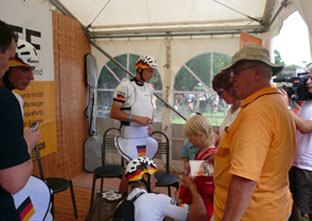 It is even essential because at this level of competition it is vital to have a boat perfectly adapted to your morphology. My boat is therefore made to measure, taking account of my paddling style, posture and, of course, my build. However, kayaking is not a discipline in which the equipment alone makes all the difference.
It is even essential because at this level of competition it is vital to have a boat perfectly adapted to your morphology. My boat is therefore made to measure, taking account of my paddling style, posture and, of course, my build. However, kayaking is not a discipline in which the equipment alone makes all the difference.
In Germany, PlasticsEurope* is one of your main sponsors. What relations do you have with them ?
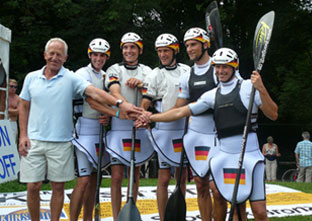 Kayaking does not attract a lot of media attention and so it has fairly few financial means. To make progress and stay at the top, it is essential to have reliable partners who support us on every occasion. From this point of view, the closer relations between our federation and PlasticsEurope are a real success story. In my country, PlasticsEurope is very much involved in nautical sports and the first partnerships date back to 1996. It is fairly logical sponsoring since plastic is by far the dominant material in the composition of boats.
Kayaking does not attract a lot of media attention and so it has fairly few financial means. To make progress and stay at the top, it is essential to have reliable partners who support us on every occasion. From this point of view, the closer relations between our federation and PlasticsEurope are a real success story. In my country, PlasticsEurope is very much involved in nautical sports and the first partnerships date back to 1996. It is fairly logical sponsoring since plastic is by far the dominant material in the composition of boats.
* PlasticsEurope is one of the leading European trade associations with offices in Brussels, Frankfurt, London, Madrid, Milan and Paris. In conjunction with European and national plastics associations, it has over 100 member companies.
Are you preparing for the London Olympics in 2012 ?
Competition in my own country is fierce. Before getting my ticket for Beijing (with the gold medal at the end of it all…), I first of all had to beat Fabian Dörfer, runner-up in the world championship, and Erik Pfannmöller, world cup winner. In Germany, there is a whole bunch of kayakers among the world elite, but only one place for the Olympic Games! I will have to make the most of myself in any case.
And what can we wish you for 2011 ?
I want a world championship medal and, above all, to continue enjoying myself on the water!
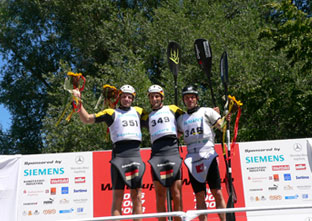
Alexander Grimm in few dates
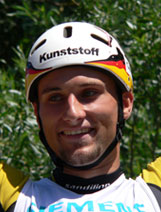 Alexander Grimm was born in 1986 in Augsburg. After winning lots of prizes in junior competitions, including the world medal in the junior world championship in 2004 in Lofer (Austria), he joined the German national team. With them he first won the team bronze medal at the 2006 world championship in Prague, followed by the gold in the same competition in 2007 at Foz do Iguaçu (Brazil) and in 2010 at Tacen (Slovenia). In the meantime, he also struck gold at the 2008 Olympic Games in Beijing (China).
Alexander Grimm was born in 1986 in Augsburg. After winning lots of prizes in junior competitions, including the world medal in the junior world championship in 2004 in Lofer (Austria), he joined the German national team. With them he first won the team bronze medal at the 2006 world championship in Prague, followed by the gold in the same competition in 2007 at Foz do Iguaçu (Brazil) and in 2010 at Tacen (Slovenia). In the meantime, he also struck gold at the 2008 Olympic Games in Beijing (China).
MORE INFORMATION





